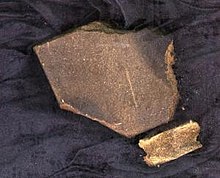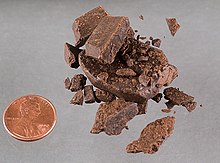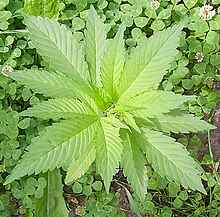hashish
Hashish (from Arabic حشيش, DMG ḥašīš 'grass') describes the resin that is obtained from parts of the female cannabis plant . It is an extract that is often pressed into plates or blocks . Common synonymous names for it are also hash or shit . Individual pieces of the pressed hashish plate are often called "piece" (less often edges or corners) .
Hashish is a brown soft resin that is insoluble in water and burns without leaving any residue on platinum sheet. The resin dissolves in ethanol, ether, chloroform, benzene , gasoline, acetone and ethyl acetate to form a golden yellow color.
In the production of high quality hashish, the inflorescences of the female cannabis plant are mainly used. The reason for this is that, compared to the rest of the plant parts, they contain significantly more resin glands with tetrahydrocannabinol (THC), the main intoxicating component of the plant.
The possession - but not the consumption - of cannabis products such as hashish is prohibited in Austria and Germany if the respective THC limit values are exceeded (for more details, see Legal Aspects of Hemp ). Consumption is also prohibited in Switzerland.
use
Hash is used both as an intoxicant and as a medicine . With its relaxing effect, it is one of the more "soft" drugs . Hashish is mostly smoked in pipes ( bong ) or as a joint , but it can also be consumed in food.
With the change in the law in Germany on March 10, 2017 with regard to “ cannabis as medicine ”, standardized extracts from the cannabis flower have become part of the therapeutic options and can be covered by health insurance companies.
ingredients
In the hemp plant Cannabis sativa 483 (status: 2007) different ingredients could be identified so far. These include at least 113 cannabinoids and more than 140 terpene derivatives . Since there are now many synthetic cannabinoids on the market, the cannabinoids from the hemp plant are called phytocannabinoids . The ingredients of the cannabis resin can be roughly divided into cannabinoid and non-cannabinoid substances.
THC content
The cannabinoids make up to 80% of the resin, whereby the content of Δ-9-THC can be up to over 30%. Hashish seized by the police in Europe contained between 4 and 28% THC in 2015. Non-cannabinoid components are flavonoids , spiroindanes , dihydrostilbenes , dihydrophenanthrenes , sterols and alkaloids .
Conceptual
If only the extracted resin from the female plants is used, it is called hashish. However, if the resinous dried flower clusters and leaves close to the flower are used as a whole, the term marijuana is used instead . The parent plants Cannabis sativa or Cannabis indica and their hybrids contain the largest amounts of resin that is obtained from the trichomes (THC-containing glandular hairs) of the flowers and calyxes of female plants.
The most common synonym for hashish in German-speaking countries is “piece”. A piece [ pi: s ] (English piece or part ) was originally a jargon expression for a commercial amount of pressed vegetable resin. The piece is separated from the original panels or bars and sold as such to consumers. In the meantime, the expression has become so independent that the word “piece” (or the actually false “peace”) is often used synonymously with the word hashish, i.e. independent of quantity, production and shape.
Production countries
In 2003, 60 to 70 percent of the hashish used in Great Britain came from Morocco , where cannabis is mainly grown in the Rif Mountains in the north of the country on an area of around 250,000 hectares. Morocco exports around 3,000 tons of hashish a year. This means that an estimated 200,000 farmers with families - around one million Moroccans - make a living. The rest of the hashish comes from other countries and increasingly from Europe itself.
Afghanistan is not only the world's largest producer of opium , but also the largest producer of hashish revenue, as the United Nations Anti-Drugs and Crime UNODC determined in 2010 . According to the UNODC study, 145 kilograms of cannabis resin or hashish are produced per hectare in Afghanistan. In Morocco, the largest cannabis-growing country in the world, it is only 40 kilograms per hectare in comparison.
Cannabis plants grown under artificial light are richer in THC than the plants from traditional growing areas due to breeding work; they mostly come onto the market as cannabis flowers , marijuana. Hashish is also offered in Dutch coffee shops , both to smoke and to eat in pastries.
Types of hashish and their processing
Varieties and quality
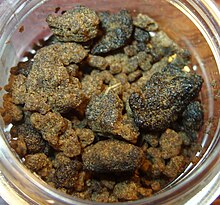
Hashish is also available in a wide variety of varieties, colors and textures. It should be noted that the active ingredient content of different varieties, plants and batches can differ considerably, which not only depends on the initial quality (1st, 2nd, 3rd, etc. sieving), but also on any extenders. Hash from traditional growing countries is often mixed with extenders such as rubber, wax, sand, damiana or henna , but also with animal fat, for example. The sale to consumers is not subject to any regulated quality assurance, mainly due to its illegal status.
In German-speaking countries, the active ingredient content of hashish does not differ much from that of cannabis flowers. This is proven by cannabis samples from the Federal Criminal Police Office, which even showed a higher average concentration of active substances in cannabis flowers in 2004.
Typing the hippie era
The old traditional varieties from around the 1970s were roughly divided according to growing areas or colors:
- “Black Afghan” and other “black” varieties (from Nepal, India, Pakistan etc.). Legend has it that the resin is obtained by rubbing it off the growing plant. The still light resin is kneaded and compressed until the resin glands burst open and it is black in color.
- The plants from which the " Red Lebanese " is obtained are left in the field until the resin glands are fully mature and have taken on a golden-yellow to reddish color. Then the whole plants above the ground are cut off and tapped in boxes or containers. The mature resin glands break off, fall to the ground and are then pressed into so-called pucks.
- Moroccan hashish (formerly also “Green Turk”) is harvested, dried and then sieved in several passes. This results in different quality levels. The green is created by more coarse plant material in the lower quality levels.
Processing equipment
The production of hashish in Morocco and Europe is done with sieves of defined mesh size, with the help of which the very fine trichomes (those plant components that contain the most resin and thus THC) are separated from the remaining plant parts. Common sieve devices for hashish making in Europe are handhashmakers, bubble bags (Ice-O-Lators) and pollinators. The resin powder obtained through dry sieving is also called skuff or kief and is usually pressed into hashish. A lightly pressed Skuff product is also called pollen , polm or pollum , but does not contain, as the name might suggest, bee pollen. The hashish obtained through “Bubble Bags” or “Ice-O-Lator” by sieving marijuana in ice water has a particularly high content of active ingredients; however, the yield is significantly lower than with dry sieving.
Processing and consumption

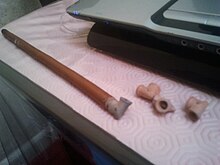
The hash is heated, crumbled and (often mixed with tobacco or knaster for easier burning ) smoked in a joint, in a small pipe or bong or inhaled with a vaporizer . It will also (in the form of biscuits or cake Engl. : Space cookies or space cakes ) eaten.
Pure hashish is more potent than marijuana with the same raw material. When taken orally, a stronger or longer effect is achieved, which occurs later (about an hour after consumption, after a few seconds to minutes when smoking). Due to the delayed effect, overdose can occur more easily than with inhalation . This can be noticeable , among other things, by a racing heart and panic .
toxicity
Main article: Tetrahydrocannabinol: toxicity
A fatal overdose in humans is impossible, and there is no direct danger to life from the consumption of cannabis.
Trivia
In literature and film
- Hashish - Documentary by Daniel Gräbner
- Robert Connell Clarke: Hashish. AT, Aarau 2000, ISBN 3-85502-669-6 .
- Walter Benjamin : About hashish. Novellistic, reports, materials. Suhrkamp, Frankfurt am Main 2000, ISBN 3-518-36521-5 .
- Friedrich Glauser : Kif . In: The narrative work, Volume 4: Cracked Glass. Zurich 1993, ISBN 3-85791-206-5 .
Nietzsche
In his autobiographical work Ecce homo , the philosopher Friedrich Nietzsche refers to hashish consumption in a subordinate clause: “If you want to get away from unbearable pressure, you need hashish. Well, I needed Wagner . "
Web links
- Giles Tremlett: Ketama Gold Puts Morocco Top of Europe's Cannabis League. Guardian Unlimited, May 27, 2003 (Figures on hashish production in Morocco)
- Hashish for al Qaeda. Prohibition promotes terrorism. ( Memento from September 21, 2008 in the Internet Archive ) Tagesschau, July 30, 2005
Individual evidence
- ↑ B. Fischer : The newer medicines: For pharmacists, doctors and druggists. 5th edition, Springer Verlag, Berlin 1893, ISBN 978-3-662-40852-0 (reprint).
- ↑ Text, amendments and justifications of the law amending narcotics law and other regulations ( BGBl. 2017 I p. 403 )
- ↑ Cannabis: Prescription aid for doctors; March 10, 2017; Franjo Grotenhermen and Klaus Häußermann; ISBN 978-3-8047-3628-3
- ↑ Oier Aizpurua-Olaizola, Umut Soydaner, Ekin Öztürk, Daniele Schibano, Yilmaz Simsir: Evolution of the Cannabinoid and Terpene Content during the Growth of Cannabis sativa Plants from Different Chemotypes . In: Journal of Natural Products . tape 79 , no. 2 , February 26, 2016, ISSN 0163-3864 , p. 324-331 , doi : 10.1021 / acs.jnatprod.5b00949 .
- ↑ European Drugs Report 2017 (PDF) Retrieved November 14, 2017 .
- ↑ Lisa Takler: Volatile compounds and antimicrobial effects of selected resins and balms from A – J. Diploma thesis, Univers. Vienna, 2015, pp. 73–79, online . (PDF; 3.18 MB), from ubdata.univie.ac.at, accessed on November 1, 2016.
- ↑ Ketama Gold puts Morocco top of Europe's cannabis league. In: www.guardian.co.uk. May 27, 2003, p. 1 , accessed June 13, 2009 .
- ↑ " UN study on cannabis Afghanistan is the world's largest hashish producer ( Memento from April 4, 2010 in the Internet Archive ) ", Tagesschau from March 31, 2010, accessed on April 1, 2010
- ↑ Bundeskriminalamt (Ed.): Bundeslagebild Rauschgift 2004. Federal Republic of Germany. (PDF) (No longer available online.) In: bka.de. May 2005, p. 44 , archived from the original on September 29, 2007 ; Retrieved July 24, 2008 .
- ↑ Laurence Cherniak: The Great Book of Hashish. ISBN 978-3-88631-223-8 .
- ↑ Hashish, the movie; August 16, 2004; Daniel Graebner; Rif movie
- ↑ Bundeskriminalamt (Ed.): Rauschgiftjahresbericht 2002. (PDF) (No longer available online.) In: bka.de. 2002, p. 214 , archived from the original on September 19, 2011 ; Retrieved July 24, 2008 .
- ^ Friedrich Nietzsche: Works in three volumes. Volume 2, edited by Karl Schlechta. Munich: Hanser, 1954, p. 1091. ( Online ).
